Earlier this month, Intel announced Alder Lake HX, a new series of 12th-generation mobile processors. Well—not strictly mobile. These new work-focused laptop CPUs are based on the company’s desktop Alder Lake chips, but in a BGA package. (That is, it’s soldered onto the motherboard, rather than being in a standard socketed LGA package that you can swap out like in a desktop PC.)
As you might guess, these new 12th-gen Core HX chips are much beefier than their standard H-class siblings found in typical gaming laptops. Alder Lake HX are 55W chips with a max turbo power rating of 157W, while Alder Lake H are 45W with 115W max turbo power.
But what does that actually mean when you’re using a laptop with an HX CPU instead of an H processor? When we got the chance to have a preview look at the new MSI GT77 Titan, we decided to put its Core i7-12800HX to the test and find out. Spoiler alert: It’s an absolute bloodbath in several scenarios, though the HX can’t claim a clean sweep across the board. In the right scenarios, however, this desktop-based chip demolishes the competition.
The test laptops
Our particular MSI GT77 configuration bundled its Core i7-12800HX with an Nvidia GeForce RTX 3070 Ti and 32GB DDR5/4800 memory. Like other high-end Alder Lake CPUs, the HX series features Intel’s new hybrid architecture, packing both performance and efficiency cores. (Sorry, no all-performance-core chips.) The 12800HX features 8P/8E cores and 24 total threads (e-cores lack hyperthreading), with a max turbo clock speed of 4.8GHz on the performance cores and 3.40GHz on the efficiency cores. It’s not the top of the stack—that distinction belongs to the Core i9-12950HX—but it still can deliver quite a punch.

Intel
Going up against this beastly processor were two other Intel mobile CPUs and one from AMD, too. An MSI GE76 Raider with Intel’s flagship Core i9-12900HK (6P/8E cores, 20 threads), an Nvidia GeForce RTX 3080 Ti, and 32GB DDR5/4800 memory served as the tribute for Alder Lake H. The 12900HK boasts a max turbo speed of 5.0GHz on the performance cores and 3.8GHz on the efficiency cores. Meanwhile, an older MSI GE76 Raider with an 11th-gen Core i9-11980HK, RTX 3080, and 32GB DDR4/3200 memory was brought out from mothballs to represent last-gen Tiger Lake H CPUs. Its chip sports 8 cores and 16 threads, with a max turbo speed of 5GHz.
As for our AMD representative, an Asus ROG Strix Scar G17 and its Ryzen 9 5900HX, RTX 3080, and 32GB DDR4/3200 memory was added to the mix. This chip is from AMD’s 2021 mobile processor launch—the 6900HX is the most current offering from AMD, but unfortunately, the 5900HX is all we had on hand. The 5900HX has 8 cores and 16 threads, with a maximum boost clock of 4.6GHz.
The lowdown
Getting a true apples-to-apples comparison between laptops is difficult, especially when comparing processors from different classes. A laptop’s size and specific design influence performance, so you can’t make hard and fast statements based on benchmarks as when comparing desktop CPUs.
Still, the numbers can give you a general idea of what to expect, even in this preview look at the HX series. Here are four quick takeaways to satiate your curiosity about Alder Lake HX.
(For a deeper dive into these results, check out the embedded YouTube video below—my colleague Gordon Mah Ung discusses the MSI GT77 and his benchmark findings in detail.)
1) Mighty performance in multithreaded tasks
Intel HX processors are clearly for when you need desktop PC power in a laptop body. The Core i7-12800HX tore through encoding, rendering, and other heavily multithreaded tasks at a pace that other laptop chips couldn’t keep up with.
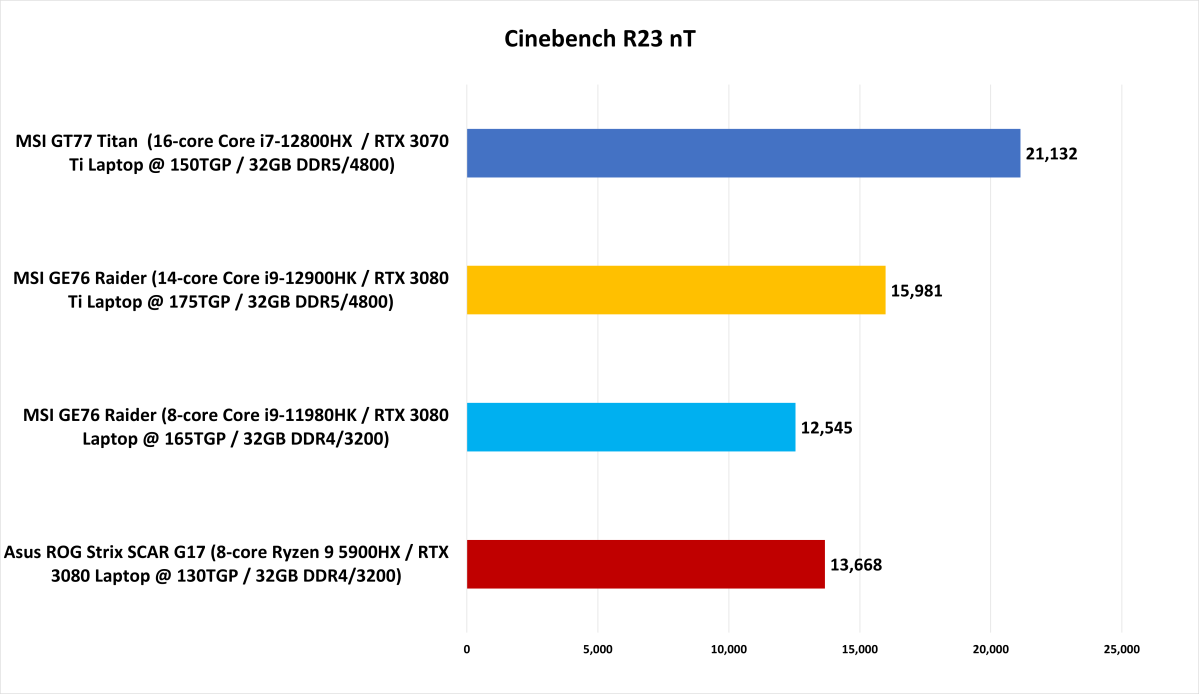
Gordon Mah Ung / PCWorld
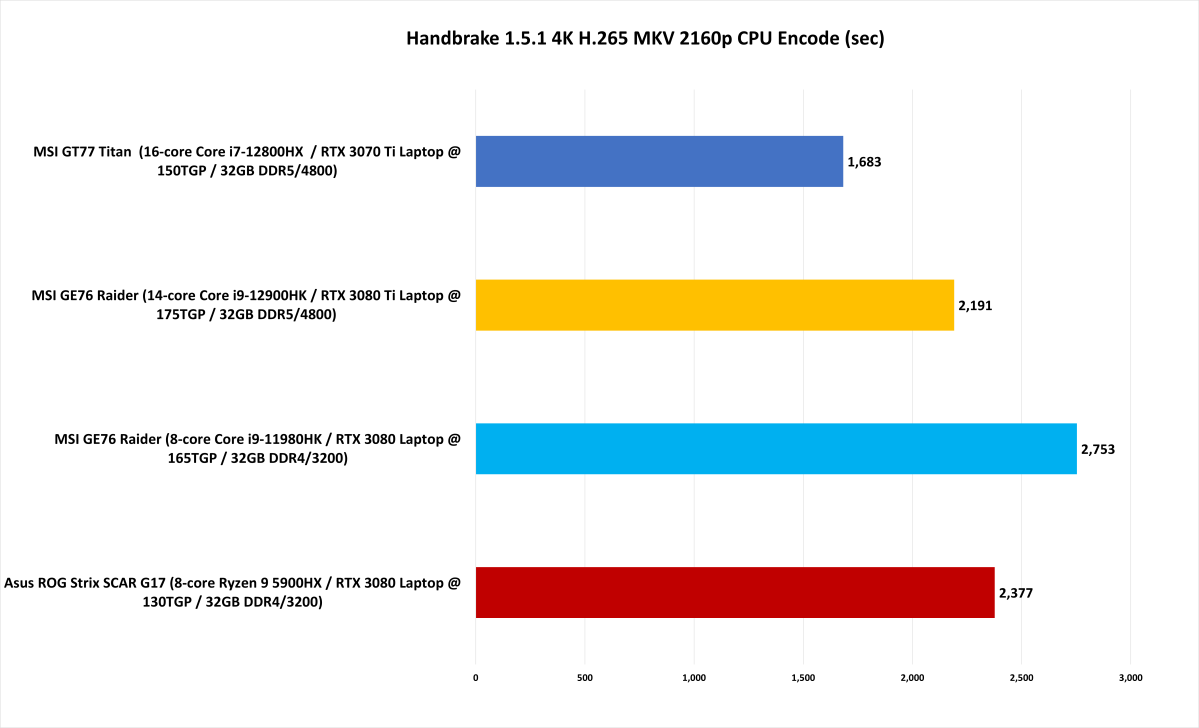
Gordon Mah Ung / PCWorld
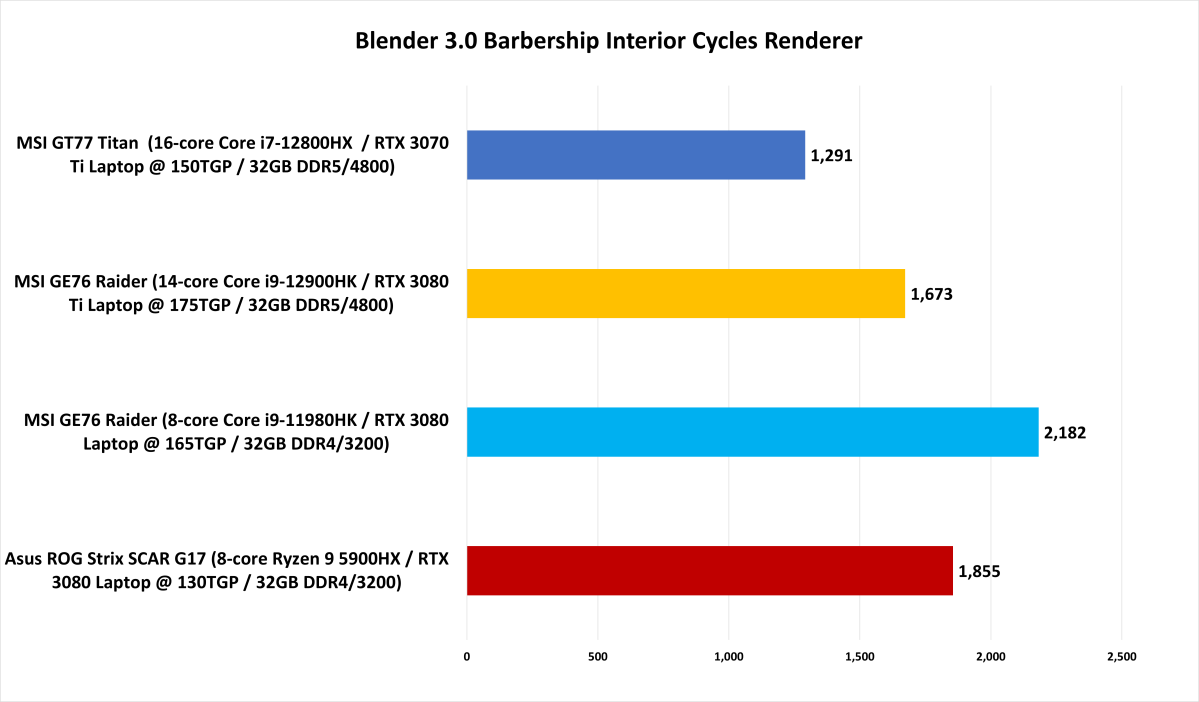
Gordon Mah Ung / PCWorld
In Maxon’s Cinebench R23 rendering benchmark, the Core i9-12800HX easily nabbed the top spot. It outperformed the runner-up, the Core i9-12900HK, by 32.23 percent. It also crushed the last-gen Core i9-11980HK and Ryzen 9 5900HX by 68.45 and 54.61 percent, respectively. The story’s similar in our Handbrake encoding test, in which we have the program crunch down Blender.org’s Tears of Steel 4K video into a smaller HEVC H.265 format. The 12800HX finishes the task about 30 percent faster than the 12900HK, 41 percent faster than the 5900HX, and 63 percent faster than the 11980HK (oof).
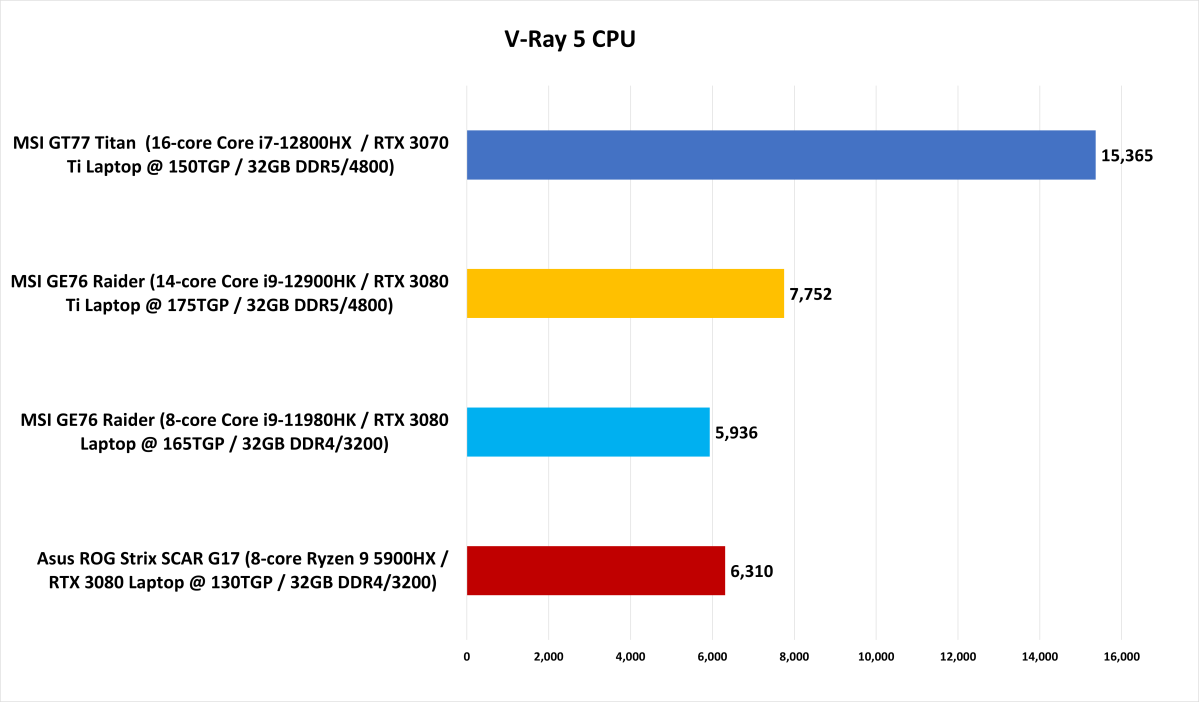
Gordon Mah Ung / PCWorld
The results are even more stark in V-Ray 5, another rendering benchmark. Here the 12800HX stomps all over the laptop processors. The improvement over the 12900HK is a whopping 98.21 percent, and it posts triple-digit percentage uplifts over the 11980HK and 5900HX.
2) A CPU alone can’t win all battles
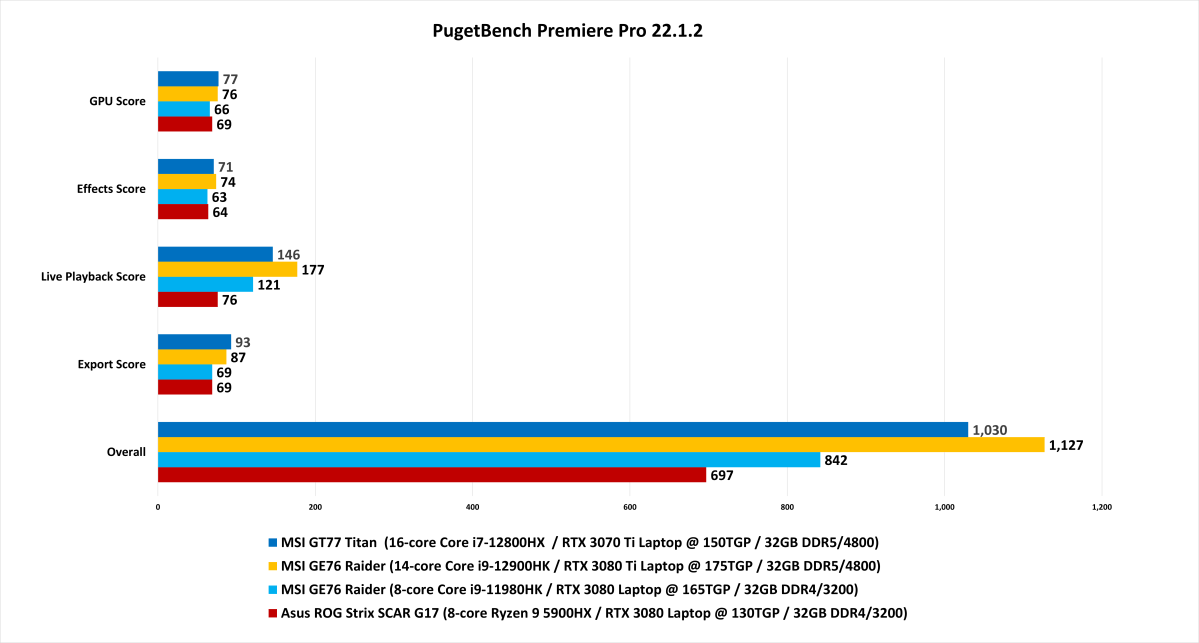
Gordon Mah Ung / PCWorld
The Core i7-12800HX doesn’t dominate in everything. A look at the results from Pugetbench’s Premiere Pro benchmark show this outcome—and more specifically, how raw CPU firepower can’t always win every round. In Premiere Pro, which makes use of both the CPU and GPU, the Core i9-12900HK and its faster RTX 3080 Ti took the top spot.
No surprises here, but it’s a good reminder that a laptop’s graphics can influence performance outcomes. Moreover, how much a discrete GPU can stretch its legs in a particular laptop makes a difference too. For example, the 12800HX’s paired RTX 3070 Ti has a decently hefty 150W TGP, but the Ryzen 9 5900HX’s RTX 3080 gets capped at just 130W TGP. That design has real world repercussions, with that Asus Scar 17 sitting firmly at the bottom of the heap.
Incidentally, we chose to run this benchmark with the discrete graphics enabled to be more true to life. You’ll never find these CPUs in a configuration lacking a dedicated GPU. However, if you’re curious, switching off the discrete graphics wouldn’t have made for an even playing ground. The 12900HK’s integrated graphics pack 96 execution units (EU), while the 12800HX sports just 32.
3) Size can make up for might
During the HX series announcement, Intel said the Core i9-12900HK would remain the top gaming CPU—but the HX chips would still be “great gaming processors as well.” Initial test results bear that out, even given the disparity in our test laptops’ specs. The 12800HX and its RTX 3070 Ti dipped below the 12900HK and its RTX 3080 Ti by only a handful of frames per second in two of our three gaming benchmarks, and it even took the lead in Counter-Strike: Global Offensive by about 5 percent. CS: GO tends to lean more on the CPU, which is likely how the 12800HK gains an advantage.
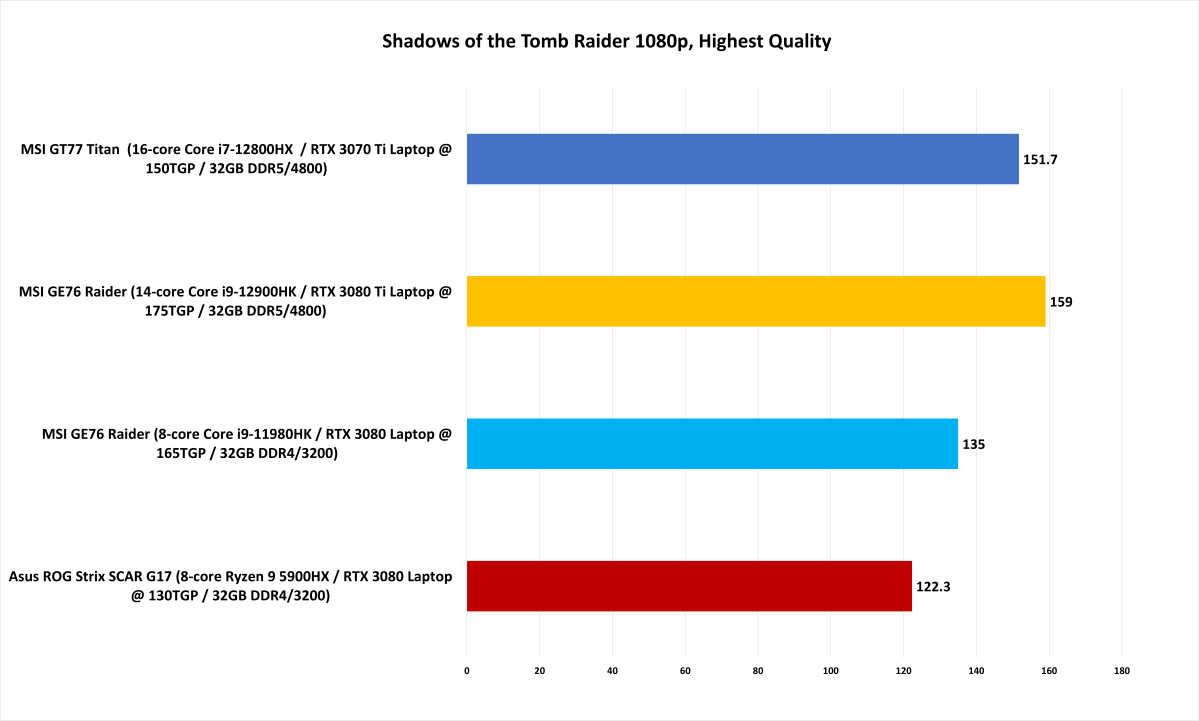
Gordon Mah Ung / PCWorld

Gordon Mah Ung / PCWorld
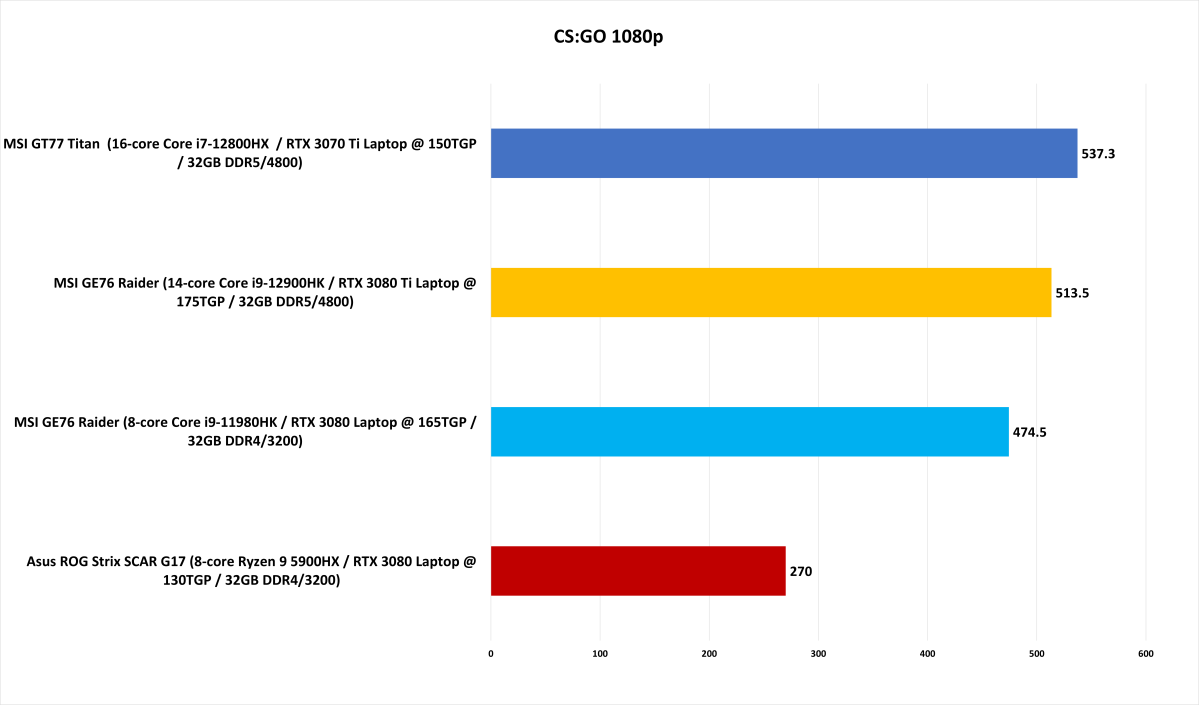
Gordon Mah Ung / PCWorld
That said, recall what we said earlier about laptop size and design. We can be sure that this 12800HX + RTX 3070 Ti laptop only slightly underperforms the MSI GE76’s 12900HK + RTX 3080 Ti, but for other laptops with similar configurations, you may not see the exact same outcome. The MSI GT77 Titan is a huge seven-pound laptop, while the MSI GE76 Raider is smaller at 6.4 pounds. Put the GE76’s components into a larger notebook and you could see a wider performance gap. And it remains to be seen what an apples-to-apples 12900HX vs a 12900HK showdown will look like.
4) Laptop housing, desktop power consumption
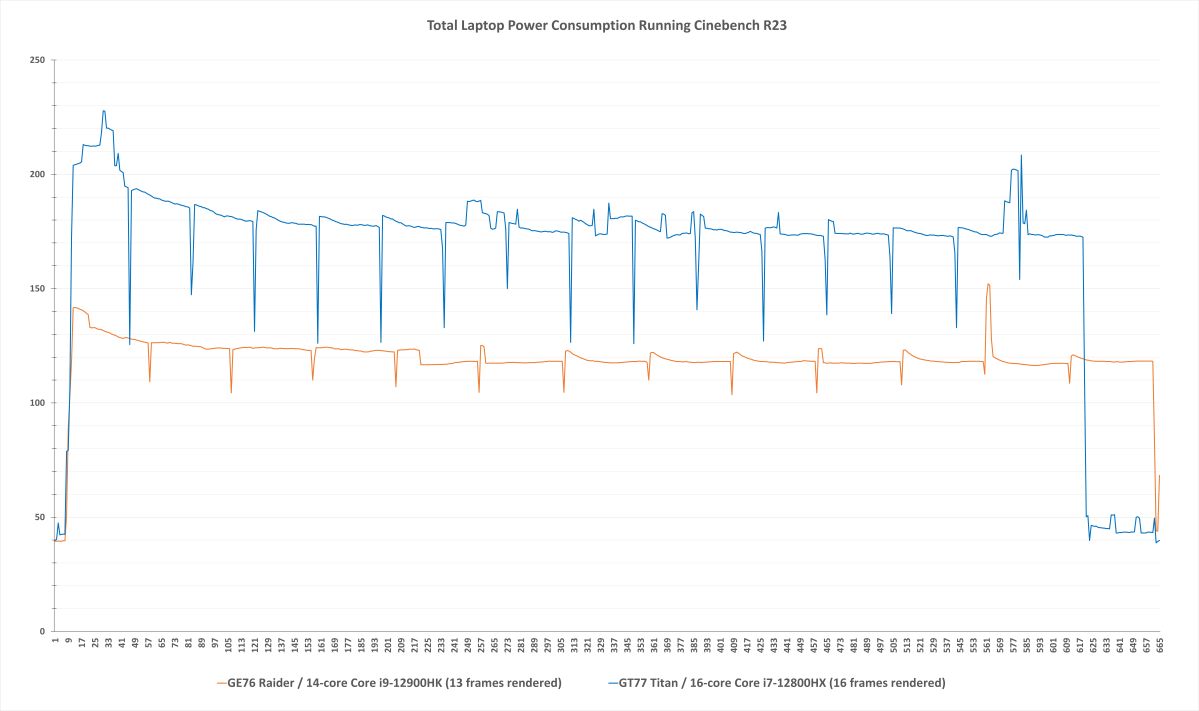
Gordon Mah Ung / PCWorld
Those who are familiar with processors already knew that the Core i9-12800HX was going to guzzle more electricity than the true laptop CPUs. When we measured power consumption during Cinebench R23’s default test, which takes 10 minutes to complete, the Core i9-12900HK hovered roughly between 120W and 130W for most of the benchmark. The 12800HX hung out closer to 180W, but with bigger drops after finishing a frame compared to the 12900HK.
What’s interesting here is seeing confirmation that 12800HX falls in line with what we usually see from more power-efficient desktop processors. (We don’t currently have this exact data for Alder Lake chips, but you can have a peek at our recent Ryzen retrospective data.) And of course, with more power comes faster and higher performance—16 frames rendered vs the 12900HK’s 13, and in less time.
Final thoughts
Even without knowing what further hardware and software tuning could improve, this performance preview makes it clear that the Core i7-12800HX is a ferociously impressive CPU. Squishing a desktop Alder Lake processor into a laptop gives quite a boost to speed. Content creators and other users who need workstation-level performance should love what’s on offer here.
That doesn’t necessarily make the HX series of chips the ideal for everyone, though. As fun as high-powered hardware is, the different classes of processors exist for a reason. If your primary need revolves around portability, a featherlight PC with an Intel or AMD U-class processor (like the recently launched Ryzen 9 6800U) is the right choice. Same for gamers—unless you’re also often creating videos based on your gameplay, you can still get plenty of enjoyment out of a laptop with a standard H-series processor. What matters more is the top performers in that class, as well as the performance of the specific laptops you’re considering.
Regardless of what you most need out of a laptop, the latest releases make choosing a new PC both easier and harder. Competition is currently so fierce between Intel and AMD that each new generation offers material benefits. Anyone trying to decide between future-proofing their purchase and saving money by going with the previous gen faces a tough call. At the same time, CPUs that stink are far more rare. It’s a good problem, all things considered.
If you’re wondering which specific notebook is the best for your personal needs, be sure to check out our roundup of the best laptops. It’s loaded with concrete recommendations culled from dozens upon dozens of recent reviews, with picks for every need and budget.
Stay connected with us on social media platform for instant update click here to join our Twitter, & Facebook
We are now on Telegram. Click here to join our channel (@TechiUpdate) and stay updated with the latest Technology headlines.
For all the latest Technology News Click Here
For the latest news and updates, follow us on Google News.
